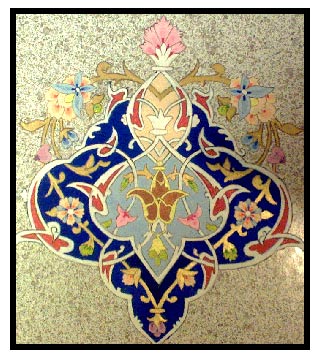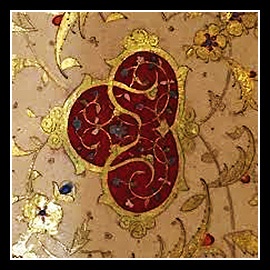History of the Persian illumination painting:

The Iranian art of illumination came to be matured during about five centuries. And the illumination manuscripts, especially the Koran, the designs of fabrics, Persian carpet, bookbinding, tiles, metalwork and architecture, all together sustained an ancient tradition. The Arabesque and decorative flowers and foliage are the results of our father’s endeavor. By the Mongol invasion and the collapse of the Kharazmshahian dynasty, the Iranian cultural and art was squandered.
The oppression of the Kharazmshahian dynasty, and their imprudence on the other hand, and encouraged by the Abbasid caliphs brought the blitz of the Mongol towards Iran.
After the Mongol invasion, thenceforth the Iranian artistic styles chiefly bookbinding, cloth-weaving, illumination, decorating palaces and other professions, became prevalent in other countries, and this has resulted in the similarity of Iranian arts and crafts among the neighboring countries.
The Mongol khan settled down in Iran, some of them becoming Moslem and initiated another era of great restoration. The golden era of Iranian art and culture had been restarted, and the royal libraries had begun their activities; illumination, painting, miniature, cloth-waving, carpet-waving, architecture and business were activated, the most beautiful illumination Koran were created in this period.
The Constructing splendid building and decorating of them revived the art of illumination. Oljaitu completed the city of Sultaniyeh. The traces of Sassanian designs can be found in that building.
During the short period of Ale-Jalayer government, there had appeared many artists creating valuable works as Divan-e Sharif by Khajuye Kermani, the beautiful painting and illuminations of which have been done by an Iranian artist, leaving behind a lasting piece of work. Sultan Ahmad Jalayer himself was a patron of art thence had encouraged the illumination painting artists.
The period of Timur has been the splendid era for all ground of Iranian art and crafts, thus the artwork of their artists, which now embellish the private and public museums of the world.
The art of Iranian illumination flourished in this period; the Timurid kings and princes has ordered to illumination the manuscripts to the Shahnameh of Ferdowsi, the Khamseh Nezami and other copies of the great poets Divans. During one century, they governed Iran powerfully, erecting buildings, monasteries, carpet-weaving factories and other industrial centers, and brightened up the economy and their relations with the adjacent countries. In the safavid period, the art of illumination increased in quality, as designing illuminated, tile, carpet patterns and decoration buildings in this era were the best artworks.
The illumination, tile and carpet designs, though shared are also distinct; the illuminated designs are but an abstract of different plant designs which are applied into a certain model. The stems and curves, with no additional leaves, and flowers have been designed in the simplest way; sometimes the illuminated patterns have been designed upon the customer’s order.
Designs of the Persian tile are very similar to those of the Iranian illumination; Persian carpet designs are more beautiful with applying flowers, leaves and other ornamentations according to the artist taste. What is more important in Persian carpet design, to be taken into consideration are features as flowers, leaves, and an ornate background, but it is not like this in illumination. In the Qajar period other artistic grounds, as pen box making, especially art illumination of the Gol-o-Morgh design had been wonderfully improved.

The painting Iranian art of illumination has passed through three phases:
– The Timurid period, in which there were no dispersion in illumination; Shahnameh Baisonghori, with magnificent illuminated designs, is the best and highlight artwork of this period
– The safavid period in the first stage of which the Timurid strong mode in the arts of illumination is evident, whereas in second stage though there appears splendid illumination designs, they are not measured identical to those of the Timurids. Shahnameh Shah Tahmasebi is a Highlight of this period, in which signs of lazuli colors and the type of binding yet pertain to the Timurid era; anyhow, the luminosity of colors, the beauty of patterns, and the evolution of some of the Timurid decorative elements can be observed in the Safavid period.
– The Qajar period has affected the art of illumination whereat disorder and beauty associates. In this period colors are lower, and the designs are lower than those of the Safavid. The illuminated designs being left from the Qajar period are very beautiful, however they are not suitable to be reproduced. Of course the critics do not consider these point, and they just pay attention to the appearance of the artworks.
© KHorshid Artwork Collection.
